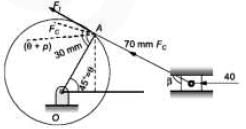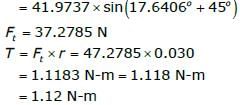Mechanical Engineering Exam > Mechanical Engineering Questions > A slider crank mechanism is shown in the figu...
Start Learning for Free
A slider crank mechanism is shown in the figure. At some instant, the crank angle is 45° and a force of 40 N is acting towards the left on the slider. The length of the crank is 30 mm and the connecting rod is 70 mm. Ignoring the effect of gravity, friction and inertial forces, the magnitude of the crankshaft torque (in Nm) needed to keep the mechanism in equilibrium is ________(correct to two decimal places).


Correct answer is '(1.12)'. Can you explain this answer?
| FREE This question is part of | Download PDF Attempt this Test |
Verified Answer
A slider crank mechanism is shown in the figure. At some instant, the ...





|
Explore Courses for Mechanical Engineering exam
|

|
Similar Mechanical Engineering Doubts
A slider crank mechanism is shown in the figure. At some instant, the crank angle is 45° and a force of 40 N is acting towards the left on the slider. The length of the crank is 30 mm and the connecting rod is 70 mm. Ignoring the effect of gravity, friction and inertial forces, the magnitude of the crankshaft torque (in Nm) needed to keep the mechanism in equilibrium is ________(correct to two decimal places).Correct answer is '(1.12)'. Can you explain this answer?
Question Description
A slider crank mechanism is shown in the figure. At some instant, the crank angle is 45° and a force of 40 N is acting towards the left on the slider. The length of the crank is 30 mm and the connecting rod is 70 mm. Ignoring the effect of gravity, friction and inertial forces, the magnitude of the crankshaft torque (in Nm) needed to keep the mechanism in equilibrium is ________(correct to two decimal places).Correct answer is '(1.12)'. Can you explain this answer? for Mechanical Engineering 2024 is part of Mechanical Engineering preparation. The Question and answers have been prepared according to the Mechanical Engineering exam syllabus. Information about A slider crank mechanism is shown in the figure. At some instant, the crank angle is 45° and a force of 40 N is acting towards the left on the slider. The length of the crank is 30 mm and the connecting rod is 70 mm. Ignoring the effect of gravity, friction and inertial forces, the magnitude of the crankshaft torque (in Nm) needed to keep the mechanism in equilibrium is ________(correct to two decimal places).Correct answer is '(1.12)'. Can you explain this answer? covers all topics & solutions for Mechanical Engineering 2024 Exam. Find important definitions, questions, meanings, examples, exercises and tests below for A slider crank mechanism is shown in the figure. At some instant, the crank angle is 45° and a force of 40 N is acting towards the left on the slider. The length of the crank is 30 mm and the connecting rod is 70 mm. Ignoring the effect of gravity, friction and inertial forces, the magnitude of the crankshaft torque (in Nm) needed to keep the mechanism in equilibrium is ________(correct to two decimal places).Correct answer is '(1.12)'. Can you explain this answer?.
A slider crank mechanism is shown in the figure. At some instant, the crank angle is 45° and a force of 40 N is acting towards the left on the slider. The length of the crank is 30 mm and the connecting rod is 70 mm. Ignoring the effect of gravity, friction and inertial forces, the magnitude of the crankshaft torque (in Nm) needed to keep the mechanism in equilibrium is ________(correct to two decimal places).Correct answer is '(1.12)'. Can you explain this answer? for Mechanical Engineering 2024 is part of Mechanical Engineering preparation. The Question and answers have been prepared according to the Mechanical Engineering exam syllabus. Information about A slider crank mechanism is shown in the figure. At some instant, the crank angle is 45° and a force of 40 N is acting towards the left on the slider. The length of the crank is 30 mm and the connecting rod is 70 mm. Ignoring the effect of gravity, friction and inertial forces, the magnitude of the crankshaft torque (in Nm) needed to keep the mechanism in equilibrium is ________(correct to two decimal places).Correct answer is '(1.12)'. Can you explain this answer? covers all topics & solutions for Mechanical Engineering 2024 Exam. Find important definitions, questions, meanings, examples, exercises and tests below for A slider crank mechanism is shown in the figure. At some instant, the crank angle is 45° and a force of 40 N is acting towards the left on the slider. The length of the crank is 30 mm and the connecting rod is 70 mm. Ignoring the effect of gravity, friction and inertial forces, the magnitude of the crankshaft torque (in Nm) needed to keep the mechanism in equilibrium is ________(correct to two decimal places).Correct answer is '(1.12)'. Can you explain this answer?.
Solutions for A slider crank mechanism is shown in the figure. At some instant, the crank angle is 45° and a force of 40 N is acting towards the left on the slider. The length of the crank is 30 mm and the connecting rod is 70 mm. Ignoring the effect of gravity, friction and inertial forces, the magnitude of the crankshaft torque (in Nm) needed to keep the mechanism in equilibrium is ________(correct to two decimal places).Correct answer is '(1.12)'. Can you explain this answer? in English & in Hindi are available as part of our courses for Mechanical Engineering.
Download more important topics, notes, lectures and mock test series for Mechanical Engineering Exam by signing up for free.
Here you can find the meaning of A slider crank mechanism is shown in the figure. At some instant, the crank angle is 45° and a force of 40 N is acting towards the left on the slider. The length of the crank is 30 mm and the connecting rod is 70 mm. Ignoring the effect of gravity, friction and inertial forces, the magnitude of the crankshaft torque (in Nm) needed to keep the mechanism in equilibrium is ________(correct to two decimal places).Correct answer is '(1.12)'. Can you explain this answer? defined & explained in the simplest way possible. Besides giving the explanation of
A slider crank mechanism is shown in the figure. At some instant, the crank angle is 45° and a force of 40 N is acting towards the left on the slider. The length of the crank is 30 mm and the connecting rod is 70 mm. Ignoring the effect of gravity, friction and inertial forces, the magnitude of the crankshaft torque (in Nm) needed to keep the mechanism in equilibrium is ________(correct to two decimal places).Correct answer is '(1.12)'. Can you explain this answer?, a detailed solution for A slider crank mechanism is shown in the figure. At some instant, the crank angle is 45° and a force of 40 N is acting towards the left on the slider. The length of the crank is 30 mm and the connecting rod is 70 mm. Ignoring the effect of gravity, friction and inertial forces, the magnitude of the crankshaft torque (in Nm) needed to keep the mechanism in equilibrium is ________(correct to two decimal places).Correct answer is '(1.12)'. Can you explain this answer? has been provided alongside types of A slider crank mechanism is shown in the figure. At some instant, the crank angle is 45° and a force of 40 N is acting towards the left on the slider. The length of the crank is 30 mm and the connecting rod is 70 mm. Ignoring the effect of gravity, friction and inertial forces, the magnitude of the crankshaft torque (in Nm) needed to keep the mechanism in equilibrium is ________(correct to two decimal places).Correct answer is '(1.12)'. Can you explain this answer? theory, EduRev gives you an
ample number of questions to practice A slider crank mechanism is shown in the figure. At some instant, the crank angle is 45° and a force of 40 N is acting towards the left on the slider. The length of the crank is 30 mm and the connecting rod is 70 mm. Ignoring the effect of gravity, friction and inertial forces, the magnitude of the crankshaft torque (in Nm) needed to keep the mechanism in equilibrium is ________(correct to two decimal places).Correct answer is '(1.12)'. Can you explain this answer? tests, examples and also practice Mechanical Engineering tests.

|
Explore Courses for Mechanical Engineering exam
|

|
Suggested Free Tests
Signup for Free!
Signup to see your scores go up within 7 days! Learn & Practice with 1000+ FREE Notes, Videos & Tests.























